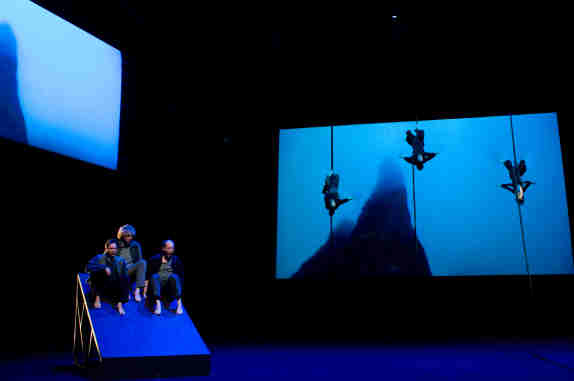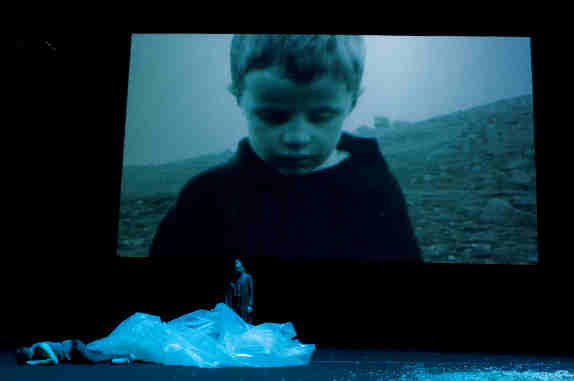Other Links
Editorial Board
-
Editor - Bill Kenny
-
Deputy Editor - Bob Briggs
Founder - Len Mullenger
Google Site Search
SEEN AND HEARD UK MUSIC FESTIVAL REVIEW
St Kilda is one of the most remote places in Europe. An archipelago about 100 miles off the north-west mainland of Scotland, it sustained a community until 1930 when the 36 remaining inhabitants were evacuated to the mainland. For generations they had survived by living off the vast communities of sea birds (mostly puffins and gannets) that thrive on the islands. Their rent was paid in feathers and oil and the islanders survived by harvesting birds’ eggs and by eating the birds themselves. St Kilda also contains some of the most dramatic scenery anywhere, including the highest sea cliff in the UK, rising to more than 400 metres. All this makes it a fantastically romantic place for the creative imagination, and this “opera” is one of the most exciting recent responses to all that St Kilda represents. It was premiered in 2007 at five simultaneous locations in Scotland, Belgium, France, Germany and Austria and its creative team is drawn from as far afield as France, Belgium, Canada and Finland. This production sees its first performances in Edinburgh.
The all-important film background was more problematic, a mixture of scenes filmed on the island in the last days of its habitation in the 1920s and ‘30s together with a black and white “mockumentary” filmed in 2006-7, based on accounts from the last inhabitants and their descendants. The poignant imagery of the final islanders was by far the most powerful footage and it stood in contrast to the rather hackneyed modern colour sequences which represented a modern group returning to the island and struck me as rather blunt and amateurish in comparison. In contrast to these was specially filmed footage of acrobatic dancers on the cliffs of St Kilda which were specatcular. More arresting still, however, was the remarkable action on stage at the time: on two occasions the acrobats performed some truly breathtaking vertical dancing using ropes suspended from above the stage. Combined with the music the effect was quite mesmerising. Other memorable images included a woman in a white dress swaying numbly on a harness, like a pendulum running its course, and a beautifully lit dance using a shower of white feathers in the darkness.
Edinburgh International Festival 2009 (I) - St Kilda, Island of the Birdmen:
Edinburgh Festival Theatre, 15.8.2009 (SRT)
Catriona: Alyth McCormack
John: Alain Eloy
Choeur et acrobates des Hainauts
Ensemble Musiques Nouvelles
Jean-Paul Dessy Musical director
Thierry Poquet Director

It is, if anything, reductive to refer to
The story, what there is of it, is a broadly symbolic comment on the island’s depopulation and eventual abandonment. Rachel and Neil, two young islanders, fall in love and marry on the main island of Hirta but shortly afterwards the men are marooned on the smaller island of Boreray due to a badly tied boat. While they are stuck there an outbreak of cholera ravages the women on Hirta and, amid various ominous portents, Neil falls to his death, symbolising the loss of hope for the next generation. The island’s remaining inhabitants reluctantly decide that they have no alternative but to abandon their way of life and be resettled on the mainland. Their spirit lives on, however, through the enigmatic characters of John and Catriona who embody the spirit of the young lovers but also that of the islanders as a whole.
Clearly, then, this piece is not an attempt to tell a straight story: instead it achieves its effect through profoundly layered symbolism. The musical performances are uniformly excellent: the small chorus embody a number of concepts as well as various conventional roles (for example fishermen or keening wives) and they are exceptionally accomplished vocal actors. When required they sound as one body, such as in the opening chorale which established the islanders’ spirit, but when necessary they can sound fractured and distorted to immensely powerful effect, such as when the omens of death begin to gather in the second act. The speaking role of John is difficult to pull off and Alain Eloy didn’t seem altogether comfortable in it: his pronunciation took a while to tune into, a particular problem when his unaccompanied monologue is the first thing we hear and is so important for setting the scene. He was at his best when most active, galloping through the chorus in Act 1 or wrestling frantically with a gigantic sheet of plastic which had fallen across the stage just as the action began to take a darker turn. The real vocal standout, however, was Alyth McCormack as Catriona, more of a symbol than a character. Hailing from the Isle of Lewis, McCormack is a native Gaelic speaker and her vocal contribution consists of singing traditional-sounding Gaelic airs against the unfolding action. She has a real empathetic ability to adjust the tone of her voice so as to meet the mood of whatever situation, be it the carefree brightness of her early songs or the blood-curdling laments which she later turns to. This production would really be unthinkable without her: the audience saw her as the embodiment of the piece and her movement was every bit as well-crafted as her beautiful voice. The five musicians of Ensemble Musiques Nouvelles cope impressively with the fiendishly difficult music they are given and they anchor the mood of each sequence very powerfully.

Mostly, then, visuals and music worked well together, but a more enduring problem lay with the frequent use of speech. The work uses three languages: Gaelic, English and French. The context makes the Gaelic and English necessary and the use of French was understandable due to the circumstances of its creation and premiere. But was it really necessary to retain such lengthy passages of spoken dialogue in French now? Surely giving these speeches in English, or at least presenting surtitles, would have made the whole action much more immediate to the audience and thus heightened the dramatic impact. As it was, without detailed study of the programme notes it would have been easy to have become lost in the course of the evening.
The finest sequence, however, was the closing ten minutes as the islanders prepare to leave their home for ever. The chorus take the aforementioned plastic sheet and gently drop it into the orchestra pit against the backdrop of footage showing the real evacuation of the 1930s. The hypnotic chorale and spellbinding lament evokes a world of longing as all the performers gradually leave both stage and pit, leaving only the unbearably poignant threnody of a solo cello to accompany the stage as it fades to black. Magical.
A unique evening, then, and one that it really needs a
The Edinburgh International Festival runs until Sunday 6th
September at venues across the city. For full details go
to
www.eif.co.uk
Simon Thompson
Pictures courtesy of Edinburgh International Festival 2009
